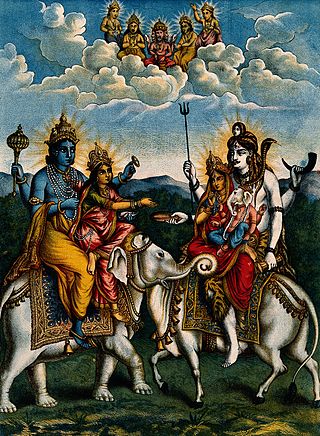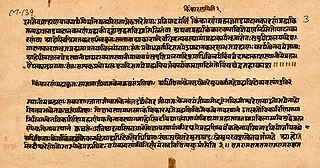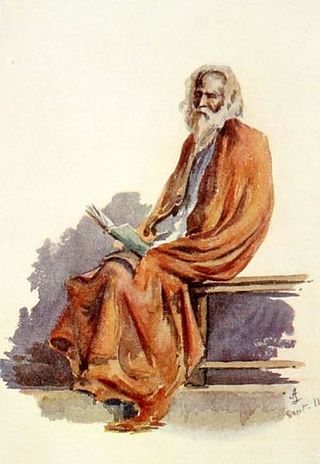
Sutra in Indian literary traditions refers to an aphorism or a collection of aphorisms in the form of a manual or, more broadly, a condensed manual or text. Sutras are a genre of ancient and medieval Indian texts found in Hinduism, Buddhism and Jainism.

The Upanishads are late Vedic and post-Vedic Sanskrit texts that "document the transition from the archaic ritualism of the Veda into new religious ideas and institutions" and the emergence of the central religious concepts of Hinduism. They are the most recent addition to the Vedas, the oldest scriptures of Hinduism, and deal with meditation, philosophy, consciousness, and ontological knowledge. Earlier parts of the Vedas dealt with mantras, benedictions, rituals, ceremonies, and sacrifices.

Adi Shankara, also called Adi Shankaracharya, was an Indian Vedic scholar and teacher (acharya) of Advaita Vedanta. Reliable information on Shankara's actual life is scanty, and his true impact lies in his "iconic representation of Hindu religion and culture," despite the fact that most Hindus do not adhere to Advaita Vedanta. He is seen as "the one who restored the Hindu dharma against the attacks of the Buddhists and in the process helped to drive Buddhism out of India." Tradition also portrays him as the one who reconciled the various sects with the introduction of the Pañcāyatana form of worship, the simultaneous worship of five deities – Ganesha, Surya, Vishnu, Shiva and Devi, arguing that all deities were but different forms of the one Brahman, the invisible Supreme Being.
Vedanta, also known as Uttara Mīmāṃsā, is one of the six orthodox (āstika) traditions of textual exegesis and Hindu philosophy. The word "Vedanta" means "conclusion of the Vedas", and encompasses the ideas that emerged from, or aligned and reinterpreted, the speculations and enumerations contained in the Upanishads, focusing, with varying emphasis on devotion and knowledge, and liberation. Vedanta developed into many traditions, all of which give their specific interpretations of a common group of texts called the Prasthānatrayī, translated as "the three sources": the Upanishads, the Brahma Sutras and the Bhagavad Gita.

Advaita Vedanta is a Hindu tradition of textual exegesis and philosophy and a Hindu sādhanā, a path of spiritual discipline and experience. In a narrow sense it refers to the scholarly tradition belonging to the orthodox Hindu Vedānta tradition, with works written in Sanskrit, as exemplified by the Vedic scholar and teacher (acharya) Adi Shankara ; in a broader sense it refers to a popular medieval and modern syncretic tradition, blending Vedānta with Yoga and other traditions and producing works in vernacular.
Jaimini was an ancient Indian scholar who founded the Mīmāṃsā school of Hindu philosophy. He is the son of Parāśara and is considered to be a disciple of sage Vyasa. Traditionally attributed to be the author of the Mimamsa Sutras and the Jaimini Sutras, he is estimated to have lived around 4th to 2nd century BCE. Some scholars place him between 250 BCE and 50 CE. His school is considered non-theistic, but emphasizes ritual parts of the Vedas as essential to dharma. Jaimini is known for his studies of the older Vedic rituals.
The Brahma Sūtras, also known as the Vedanta Sūtra, Shariraka Sūtra, and Bhikshu-sūtra, are a Sanskrit text which synthesizes and harmonizes Upanishadic ideas and practices. It is attributed to the sages Bādarāyaṇa, who is also called Vyāsa (arranger), but probably an accumulation of incremental additions and changes by various authors to an earlier work, completed in its surviving form in approx. 400–450 CE. The oldest version may be composed between 500 BCE and 200 BCE, with 200 BCE being the most likely date.

Ishvara is a concept in Hinduism, with a wide range of meanings that depend on the era and the school of Hinduism. In ancient texts of Hindu philosophy, depending on the context, Ishvara can mean supreme Self, ruler, lord, king, queen or husband. In medieval era Hindu texts, depending on the school of Hinduism, Ishvara means God, Supreme Being, personal God, or special Self. In Shaivism, Ishvara is an epithet of Shiva. In Vaishnavism it is synonymous with Vishnu, like in his epithet of Venkateswara. In traditional Bhakti movements, Ishvara is one or more deities of an individual's preference (Iṣṭa-devatā) from Hinduism's polytheistic canon of deities. In modern-day sectarian movements such as Arya Samaj and Brahmoism, Ishvara takes the form of a monotheistic God. In the Yoga school of Hinduism, it is any "personal deity" or "spiritual inspiration". In Advaita Vedanta, Ishvara is the manifested form of Brahman.

The Chandogya Upanishad is a Sanskrit text embedded in the Chandogya Brahmana of the Sama Veda of Hinduism. It is one of the oldest Upanishads. It lists as number 9 in the Muktika canon of 108 Upanishads.

The Isha Upanishad, also known as Shri Ishopanishad, Ishavasya Upanishad, or Vajasaneyi Samhita Upanishad, is one of the shortest Upanishads, embedded as the final chapter (adhyāya) of the Shukla Yajurveda. It is a Mukhya Upanishad, and is known in two recensions, called Kanva (VSK) and Madhyandina (VSM). The Upanishad is a brief poem, consisting of 17 or 18 verses, depending on the recension.

The Mandukya Upanishad is the shortest of all the Upanishads, and is assigned to Atharvaveda. It is listed as number 6 in the Muktikā canon of 108 Upanishads.

The Shvetashvatara Upanishad is an ancient Sanskrit text embedded in the Yajurveda. It is listed as number 14 in the Muktika canon of 108 Upanishads. The Upanishad contains 113 mantras or verses in six chapters.

Dhyāna in Hinduism means contemplation and meditation. Dhyana is taken up in Yoga practices, and is a means to samadhi and self-knowledge.
Maitreyi who lived during the later Vedic period in ancient India. She is mentioned in the Brihadaranyaka Upanishad as one of two wives of the Vedic sage Yajnavalkya; she is estimated to have lived around the 8th century BCE. In the Hindu epic Mahabharata and the Gṛhyasūtras, however, Maitreyi is described as an Advaita philosopher who never married. In ancient Sanskrit literature, she is known as a brahmavadini.
Uddalaka Aruni, also referred to as Uddalaka or Aruni or Uddalaka Varuni, is a revered Vedic sage of Hinduism. He is mentioned in many Vedic era Sanskrit texts, and his philosophical teachings are among the center piece in the Brihadaranyaka Upanishad and Chandogya Upanishad, two of the oldest Upanishadic scriptures. A famed Vedic teacher, Aruni lived a few centuries before the Buddha, and attracted students from far regions of the Indian subcontinent; some of his students such as Yajnavalkya are also highly revered in the Hindu traditions. Both Aruni and Yajnavalkya are among the most frequently mentioned Upanishadic teachers in Hinduism.

In Hinduism, Brahman connotes the highest universal principle, the Ultimate Reality of the universe. In major schools of Hindu philosophy, it is the non-physical, efficient, formal and final cause of all that exists. It is the pervasive, infinite, eternal truth, consciousness and bliss which does not change, yet is the cause of all changes. Brahman as a metaphysical concept refers to the single binding unity behind diversity in all that exists.

The Samaveda, is the Veda of melodies and chants. It is an ancient Vedic Sanskrit text, and is one of the sacred scriptures in Hinduism. One of the four Vedas, it is a liturgical text which consists of 1,875 verses. All but 75 verses have been taken from the Rigveda. Three recensions of the Samaveda have survived, and variant manuscripts of the Veda have been found in various parts of India.

The Jabala Upanishad, also called Jabalopanisad, is a minor Upanishad of Hinduism. The Sanskrit text is one of the 20 Sannyasa Upanishads, and is attached to the Shukla Yajurveda.

The Nirvana Upanishad is an ancient sutra-style Sanskrit text and a minor Upanishad of Hinduism. The text is attached to the Rig Veda, and is one of the 20 Sannyasa (renunciation) Upanishads. It is a short text and notable for its distilled, aphoristic presentation with metaphors and allegories.

Advaita Vedānta is the oldest extant tradition of Vedānta, and one of the six orthodox (āstika) Hindu philosophies. Its history may be traced back to the start of the Common Era, but takes clear shape in the 6th-7th century CE, with the seminal works of Gaudapada, Maṇḍana Miśra, and Shankara, who is considered by tradition and Orientalist Indologists to be the most prominent exponent of the Advaita Vedānta, though the historical fame and cultural influence of Shankara grew only centuries later, particularly during the era of the Muslim invasions and consequent reign of the Indian subcontinent. The living Advaita Vedānta tradition in medieval times was influenced by, and incorporated elements from, the yogic tradition and texts like the Yoga Vasistha and the Bhagavata Purana. In the 19th century, due to the interplay between western views and Indian nationalism, Advaita came to be regarded as the paradigmatic example of Hindu spirituality, despite the numerical dominance of theistic Bkakti-oriented religiosity. In modern times, its views appear in various Neo-Vedānta movements.















